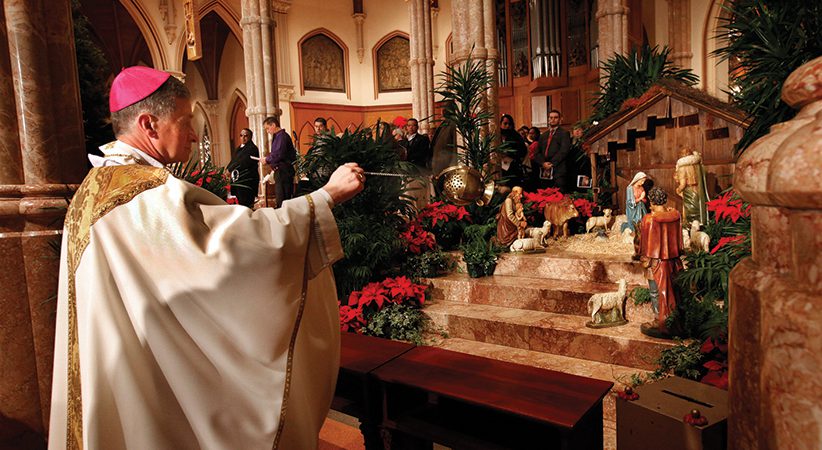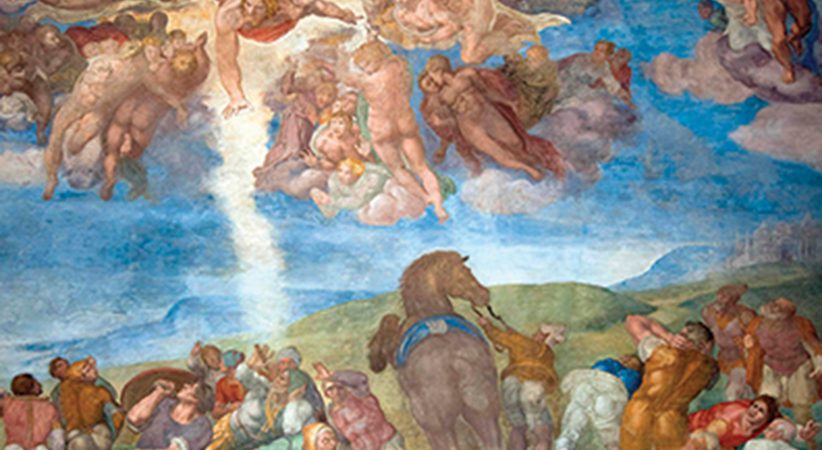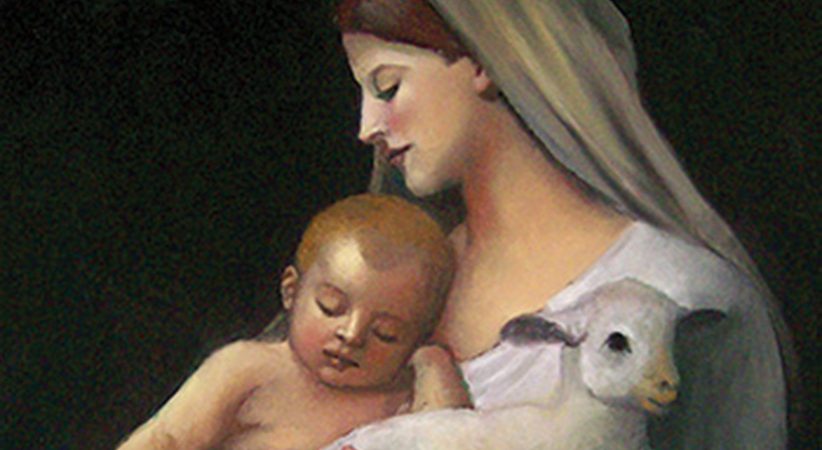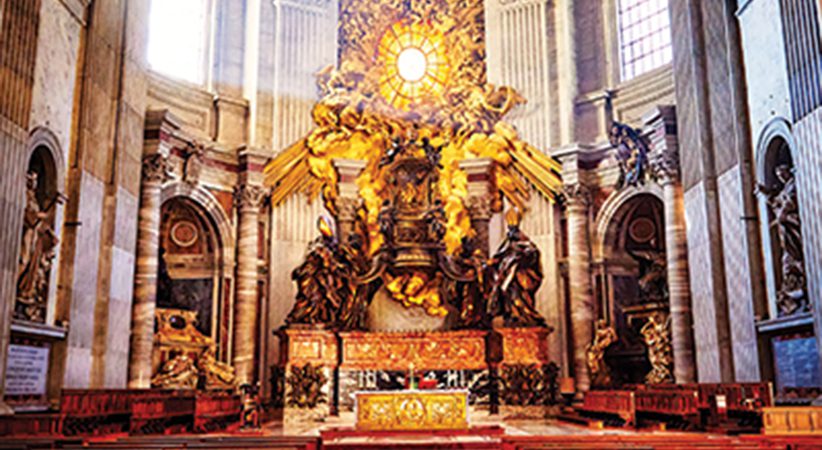Preaching the Christmas Story
Don’t be afraid to stray from the narrative in Luke, as we have much to learn from the other Gospels
Father Felix Just Comments Off on Preaching the Christmas Story
Christmas is the only day of the liturgical year on which we have four different Masses (with four sets of biblical readings). But since a note in the Lectionary allows the use of any of these sets of readings at any Mass “according to the pastoral needs of each congregation,” many parishes opt for the familiar texts from Luke rather than the selections from Matthew or John. Another consideration, of course, is the effort needed to prepare different homilies, in case a priest or deacon is preaching at several different Christmas Masses.
This article is intended to encourage you to use the readings from Matthew and John more often rather than defaulting to the Lukan story of the angels and shepherds. Another goal is to assist your preaching preparation for the last days of Advent and the early days of Christmas, when the infancy narratives are used in the Lectionary. We’ll consider the similarities and differences in the various stories about Jesus’ birth. All priests and many other Bible readers are well aware of how different John’s prologue is from the synoptic accounts of Jesus’ birth, but do you realize how different the infancy narratives in Matthew and Luke are? How much each Gospel differs, not just in content but also in the theological emphases?
If you haven’t read each account of the birth of Christ recently, I highly recommend it. It only takes a few minutes for each Gospel, but it can be an eye-opening experience. Right after reading each text, one at a time, stop to reflect on what impression it made on you. What stood out in your reading? Consider not only what episodes and details are included, but also what familiar elements are not there. What is each evangelist’s main message, and why is each story written the way it is?
Matthew and Luke have some common core elements, but they also have significant differences regarding the origins and birth of Jesus, while John’s “Word became flesh” is even more distinctive. So let’s first look at the two synoptic accounts, then also at John, all the while reflecting on how this can affect our preaching during the Advent and Christmas seasons.
Similarities in the Synoptic Accounts
While they might play different roles in each Gospel, the Matthean and Lukan infancy narratives feature the same three main characters in Mary, Joseph and Jesus, and some similar supporting characters (angels, the Holy Spirit). Matthew and Luke also agree on Jesus’ royal Jewish heritage (he is a descendant of Abraham and of the “House of David”). Both Gospels attribute some of the same titles to the newborn Jesus (“Christ” and “Son of David”), and both place the action in the same historical period (near the end of King Herod’s reign). Both Gospels mention the same two geographical locations (Nazareth in Galilee and Bethlehem in Judea), although they diverge regarding when and why the family is in each location. These are only some of the common features. These substantial overlaps provide a solid historical foundation for the core of the traditions surrounding the birth of Jesus. On the other hand, the many differences in the contents and details of the two infancy narratives must also be considered carefully.
Differences in Matthew and Luke
One obvious difference is in the length of each infancy narrative. Luke’s account is about three times as long as Matthew’s. Why? One reason is that Luke not only tells us about the conception and birth of Jesus, but also intertwines parallel stories about the origins of John the Baptist.
Given the differences, let’s not get distracted by the difficult historical questions about “what really happened”: Exactly when and where was Jesus born? What do we know historically about the census, the star, the Magi or the shepherds? Although such questions are legitimate, there is little scholarly consensus on the best answers. More importantly, historical questions should not distract us from the theological messages conveyed by the Evangelists. So rather than rehashing any arguments about historical details here, let’s focus on how the stories are told in Matthew and Luke (and in John’s Prologue).
Matthew’s Account: Jesus as King of the Jews
A noticeable feature of Matthew’s infancy narrative is that the action revolves around the male characters, with few women mentioned. In Matthew’s account, it is Joseph who repeatedly receives messages from God through his dreams and then acts on them, whereas Mary is rarely mentioned and does little more than give birth, welcome the Magi and let herself and her child be protected by Joseph. The other characters in Matthew’s account are men, mostly rich and powerful ones (King David, King Herod, the Magi from the East), along with their attendants (chief priests and scribes who advise Herod; soldiers who kill the innocents). Aside from Mary and the four women listed in the genealogy, the only other woman mentioned is “Rachel weeping for her children” (Mt 2:18).

The overall tone of Matthew’s account reflects fear and danger, conflicts and conspiracies, political struggles and even murder! King Herod feels so threatened by talk about a “newborn King of the Jews” that he schemes and acts to get rid of any perceived threats. Yet all this is related to one of Matthew’s main messages: The newborn Jesus is the legitimate “King of the Jews,” the messianic “Son of David,” in contrast to the actual (but illegitimate, in many people’s opinions) rulers: King Herod at the time of Jesus’ birth, and Herod’s sons at the time of Jesus’ public ministry and death. Not only is the claim about Jesus’ Davidic kingship stated by many characters in the story, but the evangelist also supports this claim explicitly in the titles given to Jesus and implicitly in some details of the narrative, such as the genealogy.
Since many clergy dread having to proclaim the genealogy of Jesus, filled as it is with so many hard-to-pronounce names in long, repetitive lists, they often choose the optional “shorter version” of the Gospel for Christmas Eve (Mt 1:18-25), which skips Jesus’ genealogy and focuses instead on Joseph’s dreams. This is unfortunate, since several aspects of the genealogy are so important. First, let’s consider the summary in Matthew’s concluding verse (1:17). Why are there three sections with 14 generations each? To proclaim Jesus as the Son of David! In ancient Hebrew gematria (which to us seems like a numbers game, but for them was a symbolic means of biblical interpretation), the numerical equivalent of “David” (simply spelled with Hebrew consonants Dalet-Vav-Dalet) is 4+6+4. Three letters adding up to 14; three sets of 14 generations! Note also how they are divided: The first set runs from the founder of the Jewish people (Abraham) to their greatest king (David), the second set includes all the kings of Judah down to the Babylonian exile (the end of the Davidic monarchy), and the third set ends with the announcement of the Messiah (the restoration of the Davidic monarchy)!
What about the women in the genealogy? To better understand why they are included by Matthew, we ought to re-read their biblical stories: Tamar, in a case of incest (see Gn 38:1-30); Rahab, the prostitute from Jericho (Jos 2:1-21; 6:17-25); Ruth, a foreign widow from Moab (Ru 1:1—4:22); and “the wife of Uriah,” the adulterous Bathsheba (2 Sm 11:1—12:25). Note that these women all appear in the ancestry of Kings David and Solomon, not just in the generations just before Jesus. In mentioning them, Matthew is subtly arguing against claims that Jesus cannot be the Messiah due to the rumors surrounding his birth. Matthew is basically saying, “So what?” God can work through anyone, no matter how imperfect their heritage. If no one questions the legitimacy of Kings David and Solomon, despite what we know about their ancestors, why should anyone question the legitimacy of Jesus as the royal Messiah?
To further counter any claims that Jesus was born out of wedlock, Matthew emphasizes that Jesus is indeed a legitimate member of the family of King David. Although Joseph was not the biological father — since Jesus was conceived “through the Holy Spirit” (Mt 1:18, 20) — he not only accepts Mary as his wife (1:24), but also exercises the paternal role of naming the infant (1:25b). In the culture of the day, if Joseph had said, “This is not my son,” then the child would be illegitimate. But by pronouncing the name, Joseph publicly accepts the child as his own, thus becoming the “legal father” of Jesus.
Throughout Matthew’s Gospel, much of what the evangelist claims is backed up by explicit quotations from the Hebrew Bible. This “fulfillment of Scripture” theme is already prominent in the infancy narrative, where biblical texts are directly quoted at least five times (Mt 1:22-23; 2:5-6, 15, 17-18, 23). Some of these Old Testament quotes also appear in the first readings during Advent and Christmas, reminding us to consider the connection between the Old Testament and the Gospel.
How does all this affect our preaching? Most people today no longer live in a monarchy, and even in countries that still have royalty, the king or queen is rarely an absolute ruler, as in previous centuries. So on the one hand, Matthew’s emphasis on Jesus as “the king of the Jews” might seem difficult to preach about today. On the other hand, it’s not difficult to see that today’s political powers are still threatened by Christian claims that God, in the person of Jesus, should be the ultimate “ruler” in our lives, rather than the powers claimed by any political, military or economic system.
Luke’s Account: Jesus as Savior of the World
In reading Luke’s much longer infancy narrative, one easily notices all the new episodes not mentioned in Matthew, especially the stories about the conception, birth and naming of John the Baptist, as well as the accounts of Mary visiting Elizabeth, the angels and the shepherds, the presentation of Jesus in the Temple, and finally the visit of Jesus’ family to Jerusalem when he was 12 years old.
Throughout Luke’s account, the action centers on Mary much more than on Joseph, and the other main characters are not rich and powerful men as in Matthew’s Gospel, but women like Elizabeth and Anna. If men appear in Luke, they are mostly poor (shepherds) and/or elderly (Zechariah and Simeon). Moreover, the Lukan women often play roles that are as important as their male counterparts. For example, when John is circumcised, it is Elizabeth who takes over the husband’s prerogative in naming the child (although her words are confirmed by her still-mute husband, Zechariah). Similarly, when Baby Jesus is presented in the Temple, two old people encounter him. Although Luke does not record Anna’s words, only Simeon’s, it is significant that Anna is called a prophet and is the one speaking publicly to the surrounding people, whereas Simeon had spoken only privately to Jesus’ parents and in prayer to God.
In addition to noting all the new episodes and the roles played by the various Lukan characters, we also notice how different the overall tone of Luke’s narrative is. In contrast to the fear, conflict, political intrigue and murder in Matthew’s account, Luke emphasizes joy and peace, light and glory, praise of God and salvation for humanity, and not just the people of Israel, but human beings from all nations. Although Luke’s stories include themes of poverty and humility (“no room for them in the inn”; shepherds in the fields at night; the infant “lying in a manger”), the focus is much more strongly on peace, joy and the praise and glory of God.
Recall that only Luke gives us the texts of several prayers and hymns of praise that are so important in the Church’s liturgical prayer: Mary’s Magnificat (1:46-55), Zechariah’s Benedictus (1:68-79), the angels’ Gloria (2:14), and Simeon’s Nunc Dimittis (2:29-32). Moreover, the first half of the “Hail Mary” prayer combines some words spoken to Mary by the angel Gabriel (1:28) and by her cousin Elizabeth (1:42).
Another feature of Luke’s infancy narrative is the prominent role of the Holy Spirit, as also in the rest of this Gospel, especially at the beginning and end of Jesus’ earthly ministry. One might even say that the Holy Spirit drives all the action in Luke’s Gospel, especially in the infancy narrative, where the Holy Spirit is mentioned at least seven times.
One final observation about how Luke narrates the births of John the Baptist and of Jesus. While John’s birth is told very briefly, in just two verses (1:57-58), the account of his circumcision and naming is extensive (1:59-80). The opposite is true in the case of Jesus. What happens just before and on the night Jesus is born is narrated extensively (2:1-20), whereas his circumcision and naming take up just one verse (2:21). This contrast subtly shows a difference between John, a prophet in the style of the Old Testament (more emphasis on circumcision) and Jesus, the savior who is worshiped by angels and humans alike (more emphasis on his birth).
John’s Prologue: The Word Became Flesh
The Fourth Gospel says nothing about the birth of Jesus, although it does contain several debates about Jesus’ heritage. (Is he Judean or Galilean? From Bethlehem or Nazareth? Son of Joseph or Son of God? Human or divine?) Yet the most direct testimony about Jesus’ origins is already in the Johannine prologue, which the Lectionary prescribes not just for Masses on Christmas Day but also on Dec. 31 (if it’s a weekday) and on the second Sunday after Christmas (not pertinent in the United States, since Epiphany is now celebrated that Sunday).
Since John’s prologue is mostly read during the Christmas season, many people naturally assume that the highlight of this beautifully poetic and highly theological text is the incarnation of Jesus: “And the Word became flesh and made his dwelling among us” (1:14). This impression is strengthened if one uses the “shorter version” of the Gospel reading, ending with Verse 14. A careful analysis of the whole prologue, however, shows that the Incarnation is only half of the message. In literary structures known as “chiasms” — commonly used in ancient Greek and especially often in John’s Gospel — the main point is not found at the end, but in the middle of a text. Moreover, the first and second halves of a chiastic text balance each other.
Looking carefully at John’s prologue, we see that the coming of Jesus into the world is not mentioned only in Verse 14, but already in Verse 9: “The true light, which enlightens everyone, was coming into the world.” So what is the highlight, the main message, found in the very middle of the prologue? It is not Verse 14, but in Verses 11-13, and especially Verse 12: “He came to what was his own, but his own people did not accept him. But to those who did accept him he gave power to become children of God, to those who believe in his name, who were born not by natural generation nor by human choice nor by a man’s decision but of God.”
In other words, this Gospel not only proclaims the coming of Jesus into the world (as true light and God’s Word), but also challenges us, the readers and hearers of this text, with a fundamental choice, as stated in the prologue and repeated often throughout John’s Gospel: Do we reject this message, or do we accept it? Do we believe Jesus is Son of God, or do we ignore his claims?
Therefore, even if people long to hear the more “Christmassy” stories from Luke, I urge you to read the Johannine prologue at Masses on Christmas Day — and preferably all 18 verses rather than just the short version. Our annual Christmas celebration is an opportunity for Christians not just to think back, somewhat romantically, to the birth of a baby in the manger of Bethlehem, but to reflect on how the incarnation of Jesus, the coming of God’s Word into our world, challenges us again to make this most fundamental choice: to accept and believe God’s Word, to acknowledge and proclaim Jesus as the very center of our lives!
Back to the Manger Scene
Did the Magi and the shepherds ever meet each other? Certainly not in any biblical account, and probably not historically. For this reason, I personally enjoy the tradition followed in some churches and homes of moving the various figures around as the Christmas season progresses. On Christmas Eve and Christmas Day, only the shepherds are near the crèche, while the Magi are still far away. But by the feast of the Epiphany, when the Magi have finally arrived, the shepherds have long since returned to their fields on the outskirts of Bethlehem. Such visual changes in the manger scene may help people notice the differences in the Gospel infancy narratives.
|
Like what you’re reading? Subscribe now.
|
Most importantly, let the focus of our preaching not be on any trivial or historical questions related to the Christmas story, for which there are no adequate answers. Rather, by knowing the theological emphases and thematic differences of each Gospel, good preachers can focus on Jesus in several different ways, either as “King of the Jews” (from Matthew), or as “savior of the World” (from Luke), or as “God’s Word-made-flesh” (from John).
FATHER FELIX JUST, SJ, is director of Biblical Ministries at the Loyola Institute for Spirituality in Orange, California. His website of Catholic resources (catholic-resources.org) has a wide variety of biblical, liturgical and theological materials useful both for academic studies and for pastoral applications.





